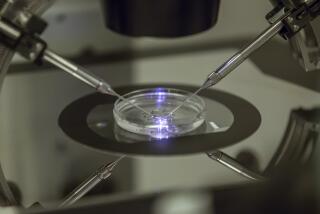Study of In Vitro Cases Backs Use of Only 2 Embryos
- Share via
Using three or more embryos at a time in test-tube fertilizations needlessly increases the risk of multiple births without boosting the odds of achieving pregnancy in most patients, according to a new government analysis being made public today involving 35,000 procedures.
The findings have prompted the leading fertility group in the United States to change its guidelines to recommend that doctors transfer just two embryos--rather than three--when treating women under 35 whose eggs appear robust.
That policy change, by the American Society for Reproductive Medicine, will potentially affect the treatment of tens of thousands of women. They include most of the women undergoing the standard in vitro fertilization procedure, in which eggs are extracted from an ovary and fertilized before being transferred to the womb.
Multiple births increase the risk of injury to mothers and babies and are considered the greatest potential hazard of medically assisted reproduction. They also present some parents with the difficult choice of aborting one or more fetuses.
The analysis, by researchers at the Centers for Disease Control and Prevention, found that 42% of women under 35 with numerous healthy-appearing eggs delivered a baby after in vitro fertilization with one or two embryos. Using three embryos yielded the same success rate but boosted the percentage of multiple births from 20% to 40% of all deliveries.
“The study is important because it identifies a subgroup of patients in whom we can reduce the risk of multiple pregnancy while maintaining a very good pregnancy rate,” said Dr. G. David Adamson, a Palo Alto fertility specialist and president of the Society for Assisted Reproductive Technology.
The new practice guidelines say that “usually no more than two good-quality embryos should be transferred” into patients with the most favorable prognosis, including women under 35 with numerous healthy-appearing eggs.
However, for women over 40 who have had no success in previous test-tube fertilization procedures, doctors may consider transferring up to five embryos. The guidelines are posted on the Web site of the American Society for Reproductive Medicine (https://www.asrm.org).
Experts in the United States and overseas have debated the issue of limiting embryos in test-tube fertilizations. British law limits doctors to transferring two embryos at a time, regardless of the woman’s age, on the theory that the risk of multiple births outweighs the higher success rate.
But U.S. doctors have resisted limits as an intrusion into the doctor-patient relationship. Also, they argue that patients in nations with free government health care are able to keep trying until they succeed. In contrast, most Americans have to pay $5,000 to $10,000 out of pocket for the procedures, putting pressure on doctors and patients to succeed right away.
The new study, published in the Journal of the American Medical Assn., largely agrees with several previous reports. But unlike a large British study published last year, it found that women 35 to 44 were more likely to deliver a baby if they received three or more embryos.
Researchers analyzed the 60,000 assisted fertility procedures at the 300 or so U.S. fertility clinics in 1996. Of those, 35,554 consisted of in vitro fertilizations involving embryos from unfrozen eggs transferred back into the women who provided them. A resulting 12,115 women became pregnant and 9,873 gave birth--a 28% success rate overall.
The younger a woman, the higher her chances of success, the study showed. For instance, 24% of women 20 to 29 gave birth after a procedure transferring two embryos, compared to 5% of women 40 to 44.
But with increased success came more multiple births. Among women 20 to 29 who received two embryos at once, nearly 6% had twins; nearly 4% who received three embryos had triplets. (In the United States, 1.1% of naturally conceived pregnancies are twins and 0.0125% are triplets.)
Dr. David Meldrum, a fertility specialist in Redondo Beach, questioned the finding that women 34 and under with apparently healthy eggs did not benefit much from transfers of more than two embryos. He argued that the mere fact that they received only two embryos suggests that they were considered healthy enough to conceive with the minimum treatment. This skews the results, he said.
The researchers, led by epidemiologist Laura Schieve, said the study “cannot completely discount” that possibility.
Research issues aside, Meldrum said he supports the new practice guidelines and will now start transferring two instead of three embryos into healthy younger patients. Newer techniques for identifying the healthiest embryos and implanting them are making that job easier, he said.
Multiple pregnancies also result from “superovulation” treatments that produce numerous eggs that are then fertilized in the womb. But experts say wider use of techniques to control and monitor ovulation can often prevent the problem.






